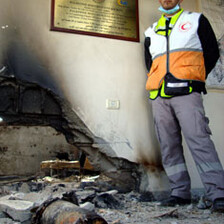I write concerning your report and photograph describing an attack on an ambulance by means of a “dart bomb” (Eva Bartlett, “Gaza’s thin red line one year later,” 22 January 2010). As a member of the United Nations Fact Finding Mission on the Gaza Conflict led by Judge Richard Goldstone, I examined this incident and offer a more precise term and also some analyses on the nature of the attack on the ambulance in question:
- The projectile that struck the ambulance was almost certainly a flechette-discharging shell fired from the main armament (that means “gun”)Â of a Merkava tank.
The shell when fired travels a distance from the barrel before discharging its flechettes or “darts.” The darts of four centimeters length (about 13 grams weight) are ejected forward in a fan-like pattern at a velocity which means that the “fan” of flechettes saturates an area up to 300 meters forward of the tank. It is therefore an ideal anti-personnel weapon designed to clear an area of underbrush forward of a tank thereby securing it from a possible infiltrator with an anti-tank gun. It goes without saying that it is entirely inappropriate against unarmed civilians in an urban area.
The arming of the shell so that it discharges its flechettes occurs 90 meters forward of the muzzle. If you examine the ambulance in question one can see that that arming process had not occurred and so therefore we can assume that the tank was “panning” the movement left to right across its front from a distance less than 90 meters away. This, in tank-shooting terms, is point blank range (zero in other words), and indeed the low-left impact site attests to the validity of my theory. In other words the ambulance was travelling at greater speed than the gunner could “pan” the gun in line with it. Poor shooting, in other words.
I visited the family of the para medic volunteer who was killed in this incident. His family was in turn struck by two missiles when they and their friends and neighbours were visiting the two mourning tents outside his parents’ house. Again by a tragic irony they too were struck by flechettes, this time however fired from missiles likely to have been mounted on Unmanned Aviation Vehicles (UAVs or ”zananna” as they had come to be known locally during Operation Cast Lead).
Finally, these flechettes are designed ballistically to “tumble” on impact with flesh. This tumbling effect increases incapacitation and is, in my opinion, a questionable additional option and should be reviewed for unacceptability or otherwise under the Conventions.
Desmond Travers is a retired Colonel of the Army of the Irish Defence Forces. He is also Director of the Institute for International Criminal Investigations (IICI) based in The Hague, The Netherlands.


